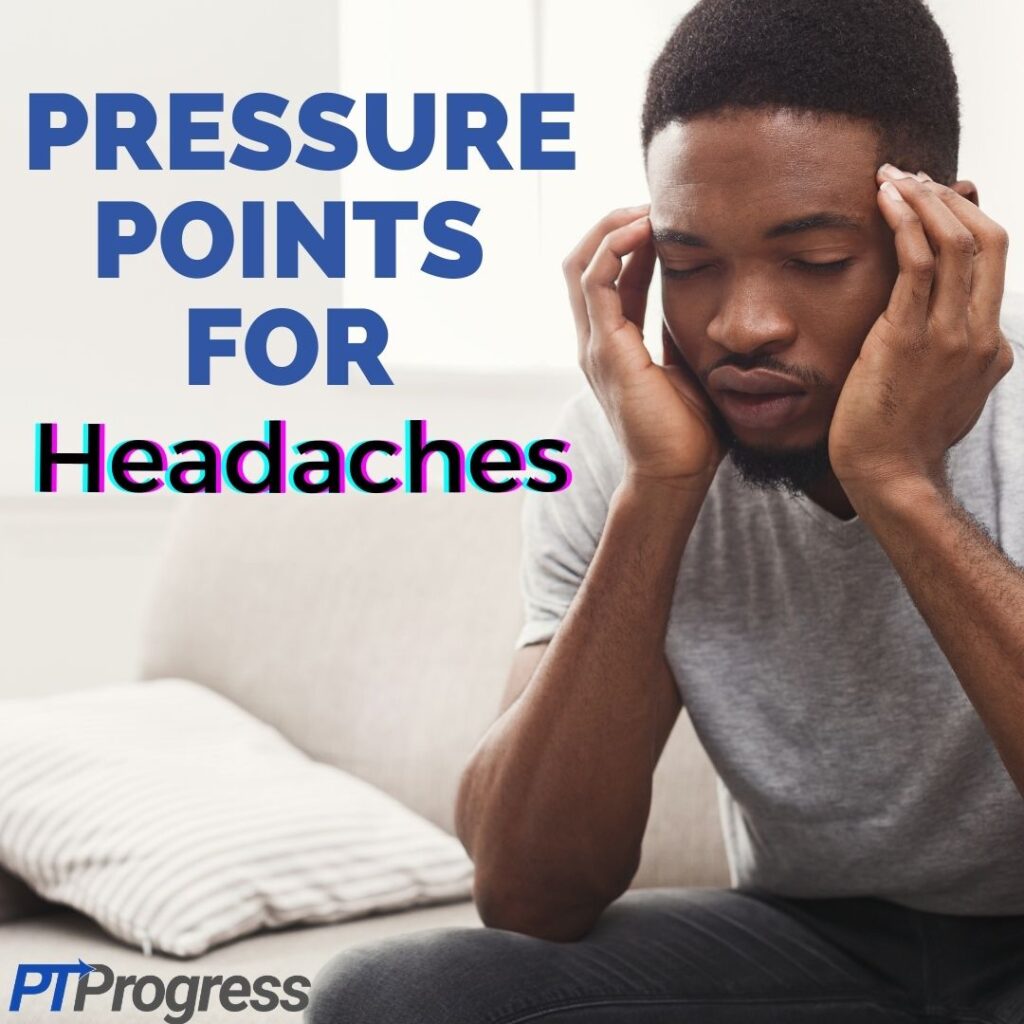A tension headache is a common side effect of the “daily grind,” but getting rid of one isn’t easy. One way to release a headache is through pressure point or trigger point massage. Let’s explore what those pressure points for headaches are, and how they work. I’ll also include some stretches you can do to relieve tension headaches as part of your daily routine.
What are Pressure Points?
Pressure points indicate areas in the body which, when manipulated, cause pain or promote healing in other parts of the body. In reflexology, these pressure points are often depicted in intricate hand maps, but in physical therapy, pressure points appear all over the body and help inform clinical massage.
It might seem far-fetched, but it’s true that massaging one part of the body can release tension in another part of the body. After all, every part of your body is connected – including those knobby knots in your shoulders! So if you’re trying to relieve pain in your head, widen your focus to other regions of the body as well.
*Scroll down to see the exercises I recommend for relieving tension headaches
Pressure Points and Headache Pain: Introducing Trigger Points
A pressure point is sensitive to pain and touch, and serves as a hub of tension in the body. When a muscle group is overworked, tension builds up and forms “trigger points” – areas of knotted myofascial tissue.
Pressing on these trigger points is sometimes painful, and you may think that the muscle itself is under strain. But trigger points are usually an indication that a nearby muscle group is overloaded. For instance, a bad knot in your upper trapezius (near the top of the shoulder) might make you think your shoulder muscles are strained. Instead, this knot more likely indicates overworked or “over-lengthened” neck muscles.
Trigger points both give and take – they receive tension from sites of overuse and refer pain to nearby regions. Let’s say the culprit is your neck muscles: they’re over-lengthened from sustaining forward head posture all day. You develop a stiff trigger point in your upper trapezius and a dull tension headache at the base of your skull.
Chances are that your posture, the knot in your shoulder, and your headache are all related. Although poor posture is the probable cause, you’re more likely to hunch when you’re in pain, further compounding the problem and prolonging your headache!
Releasing Pressure Points for Headache Relief
The good news is that, although pressure points are hubs for pain, they are also avenues for relief. Massaging these trigger points can have a domino effect on the radiating pain you feel in your head, behind your eyes, and even throughout your arms and fingers.
Trigger Points vs. Tender Points
If you’ve frequented a physical therapy clinic, you might be familiar with the term “tender points” and wonder if it’s the same as a trigger point.
While both result from nearby strained muscles, a tender point does not refer pain the same way a trigger point does. Tender points are painful to the touch but aren’t knots. A physical therapist usually treats tender points with a therapy called strain/counterstrain, wherein the tense tissue is contracted and relaxed manually to release tension and relieve pain.
You might experience lots of tender points if you have fibromyalgia. But if your ailment is chronic tension headaches, focus on trigger points, which can be found in a few pressure point areas.
Areas for Pressure Points
Pressure points in the head, neck, or shoulders are notorious for harboring trigger points and referring pain not unlike the dull headache you bring home from work every day. Let’s take a closer look at these three main areas for pressure points for headaches.
1. Suboccipital trigger point
Your suboccipital muscles lie at the base of your skull and connect your head and neck. They control head movement, both flexion and extension, as well as head rotation.
These muscles are very small and susceptible to overuse. You can strain your suboccipital muscles by looking upward or to the side too much, or more commonly, by sustaining a forward head posture.
Trigger point tension in this region usually causes pain in the temples or sides of the head and behind the ear, contributing to a headache.
2. Temporalis trigger point
On either side of your head lies the temporal muscles, which control the jaw. This flat muscle is larger than you might expect and capable of hosting four trigger points.
A tense temporalis contributes to pain in the temples as well as radiating pain in the teeth – front and back. Temporalis trigger points can also aggravate vertigo and jaw pain, including TMJ (temporomandibular joint) syndrome. Many people with a temporalis trigger point experience tension headaches in the sides of the head and over the brow.
Chewing gum, clenching teeth, and prolonged stress all contribute to a temporalis trigger point. You can release this tension through focused massage and lifestyle changes, as well as by releasing tension in the neck and shoulders.
3. Upper Trapezius trigger point
The trapezius is a large, trapezoidal muscle that extends from below your shoulder blades, across your shoulders, and up to your neck. Due to its size, this muscle is involved in nearly all movements of the head, neck, shoulders, and upper back – which, of course, is where all bad posture happens.
One of the most common trigger points is located along the upper trapezius muscle, above the collar bone. The trapezius is especially susceptible to tension from muscle strain and poor posture. As a result, these trigger points refer pain to the neck, jaw, head, and arms.
Although it can be difficult to fix, massaging specific pressure points can relax a tense trapezius. The best way to prevent trigger points in your trapezius is to correct any poor posture, such as rolled shoulders and a forward head.
Research behind Pressure Point Massage for Headache Relief
If ancient medicine is any indication, people have been massaging pressure points for headache relief since antiquity. In recent times, however, controlled trials confirm the effect of massage on tension headaches.
For people with chronic tension headaches, neck and shoulder massage can help reduce the frequency and duration of headaches. Massage that targets trigger points along the neck and shoulder can also reduce the pain of a headache when it occurs.
Besides taming headaches and releasing tension, massaging along upper-body trigger points can improve the range of motion in the neck.
Importantly, these studies showed short-term benefits of massage therapy, so it’s not a long-term fix. The best way to prevent tension headaches is to address poor posture that may be contributing to the formation of trigger points and referred pain.
How to Massage Trigger Points
For working out the kinks in your upper trapezius, suboccipital, and even your temporalis, your best tools are your hands. Apply steady pressure to a trigger point until it starts to loosen up and you feel a release in tension.
Always keep your head and neck relaxed as you massage. The best position for massaging your suboccipitalis is while lying on your back, so that your head is supported and those tiny neck muscles can get a break. While you’re lying down, try massaging your temporalis, keeping your jaw loose and relaxed.
Because the trapezius is a much larger, thicker muscle, you might benefit from some massage tools. A tennis ball or lacrosse ball can really get the job done. Simply roll it beneath your back, using the ground to press the ball into your trap where your trigger points are. Or, if this is too intense, stand up against a wall and lean onto the ball that way.
A foam roller is another great tool for applying steady pressure to trigger points. You’d use it similarly to the tennis ball while covering a wider area of your back. If nothing else, a willing elbow or thumb can do the trick of applying sustained pressure and relaxing your tight muscles.
Once you’ve loosened up the knots and released these trigger points, it’s always a good idea to follow up with some gentle stretching.
Stretches for Tension Headache Treatment & Prevention
Despite the most persistent of tension headaches, you can get relief through a routine of massaging and stretching. Just pay attention to any shooting pain or discomfort in your neck, and back off from the stretch if you need to.
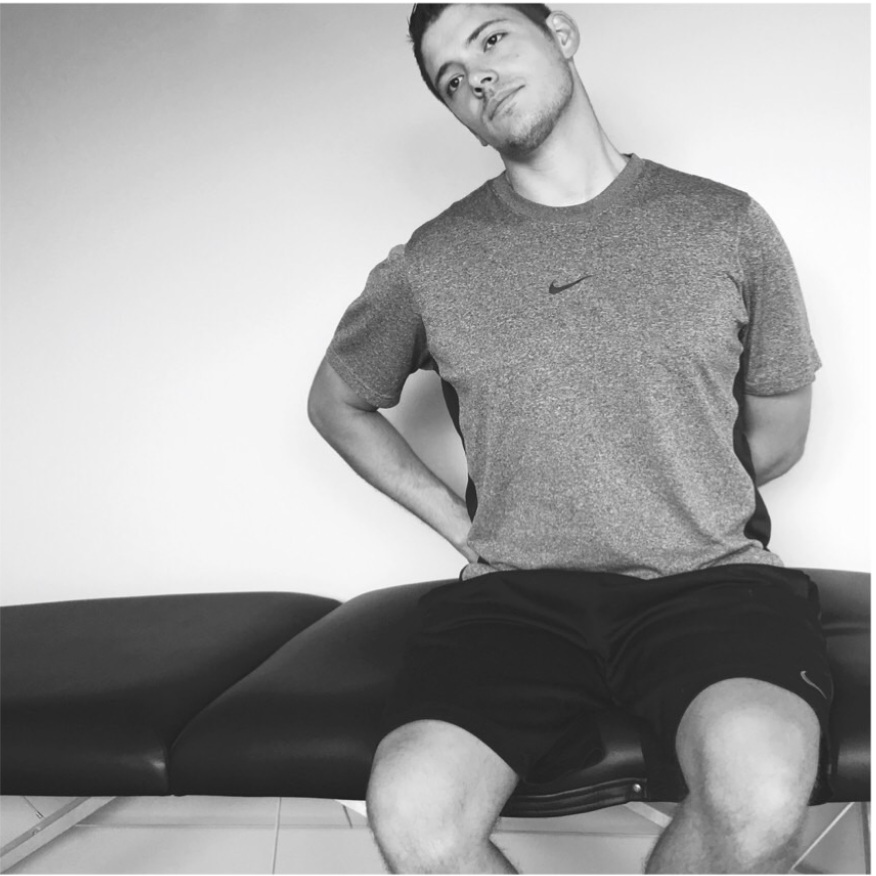
Upper trap stretch
A simple upper trap stretch can work wonders in relieving built-up tension you may have in your trapezius trigger points.
While sitting up straight, gently tilt your head to one side, keeping your head over your shoulder. Make sure you keep your shoulder down. You should feel a gentle stretch in the side of your neck opposite your head tilt. To elongate this stretch, with your fingers gently pull your head towards your shoulder. Or, tuck your opposite arm behind your back, as pictured. Hold this stretch for 15-30 seconds and repeat 3 times on each side.
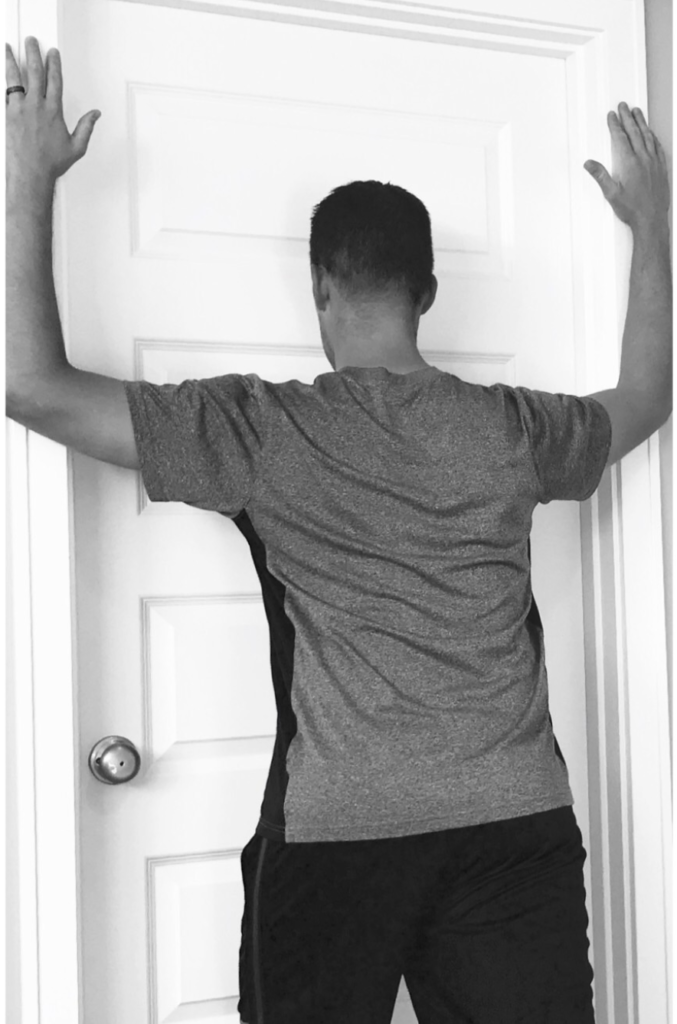
Corner Stretch
I call this the “Corner Stretch,” but you can perform it in a corner or doorway. This stretch is great for opening up the chest muscles which, if they’re tight, can contribute to the dreaded forward head posture that’s given you a headache.
Place one foot in front of the other in a “staggered stance,” facing the corner. Next, place your hands on either side of the wall, about shoulder height. Gently shift your weight to the front leg, feeling a gentle stretch through the chest, or pectoral muscles. Keep your head neutral, with your ears over your shoulders, and look towards the corner. Hold for 15-30 seconds for 4-5 repetitions.
Chin tuck
This movement strengthens the intrinsic neck muscles that support the head. Without the support of these tiny occipital muscles, the larger muscles will overpower the head and precipitate forward head posture.
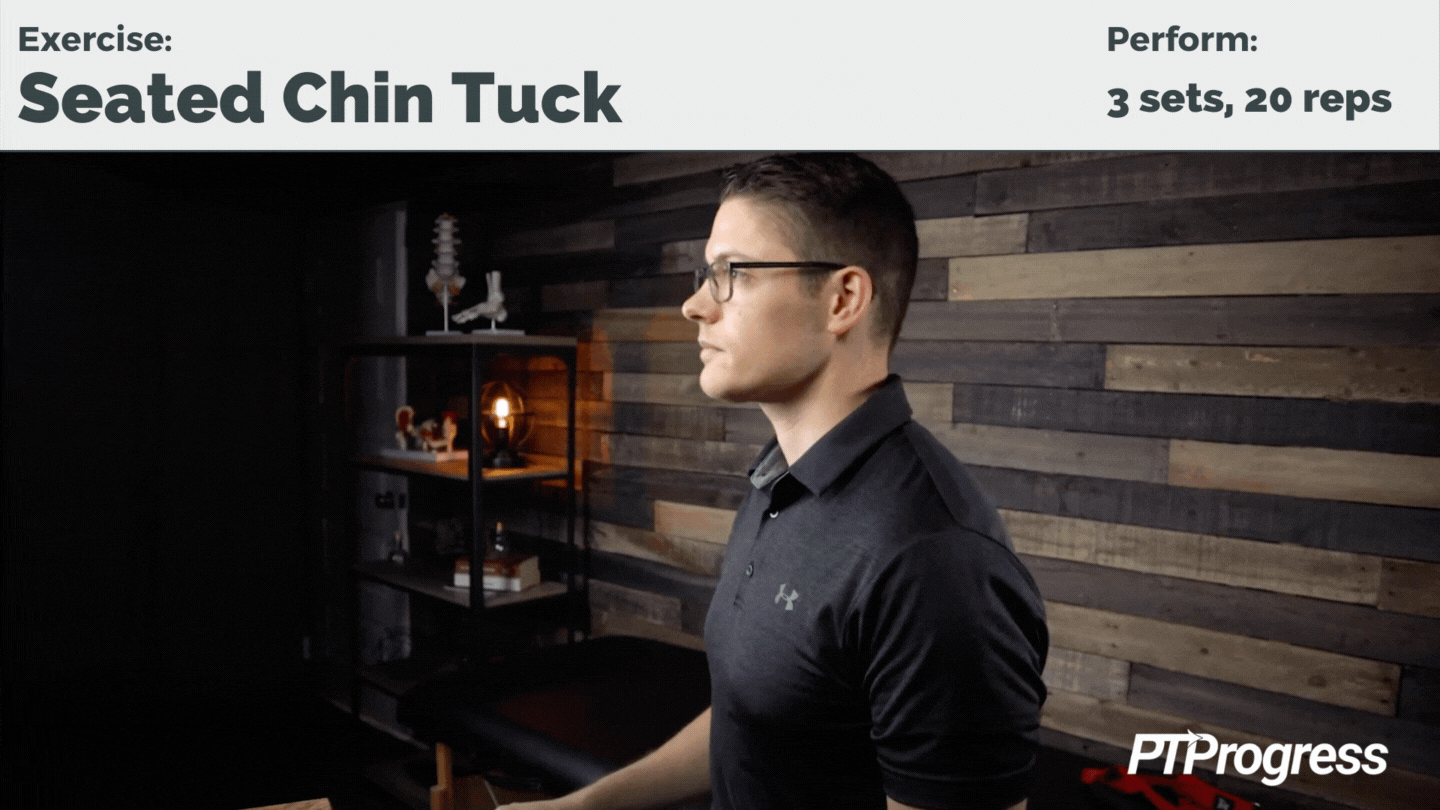
To perform a chin tuck, first stand or sit up straight. Gently bring your chin down towards your chest and give yourself a double chin. For a good stretch, hold the a chin tuck for 10-15 seconds; or as an exercise, perform 20 chin tucks, holding each one for 2-3 seconds. As you repeat the motion, imagine that you’re spinning a rod with your chin.
You’ll know you’re doing the chin tuck correctly if you feel a slight pulling along the back of your neck. What you’re feeling is that trigger point releasing scrunched-up tension. To intensify it, use your fingers to apply a gentle pressure at your chin or along the base of your skull at the trigger point.
Scapular Retraction
The name might sound intimidating, but “scapular retraction” simply means “shoulder squeezes.” Retraction not only improves your overall posture but also activates the trapezius muscles and helps reduce tension in the trigger points.
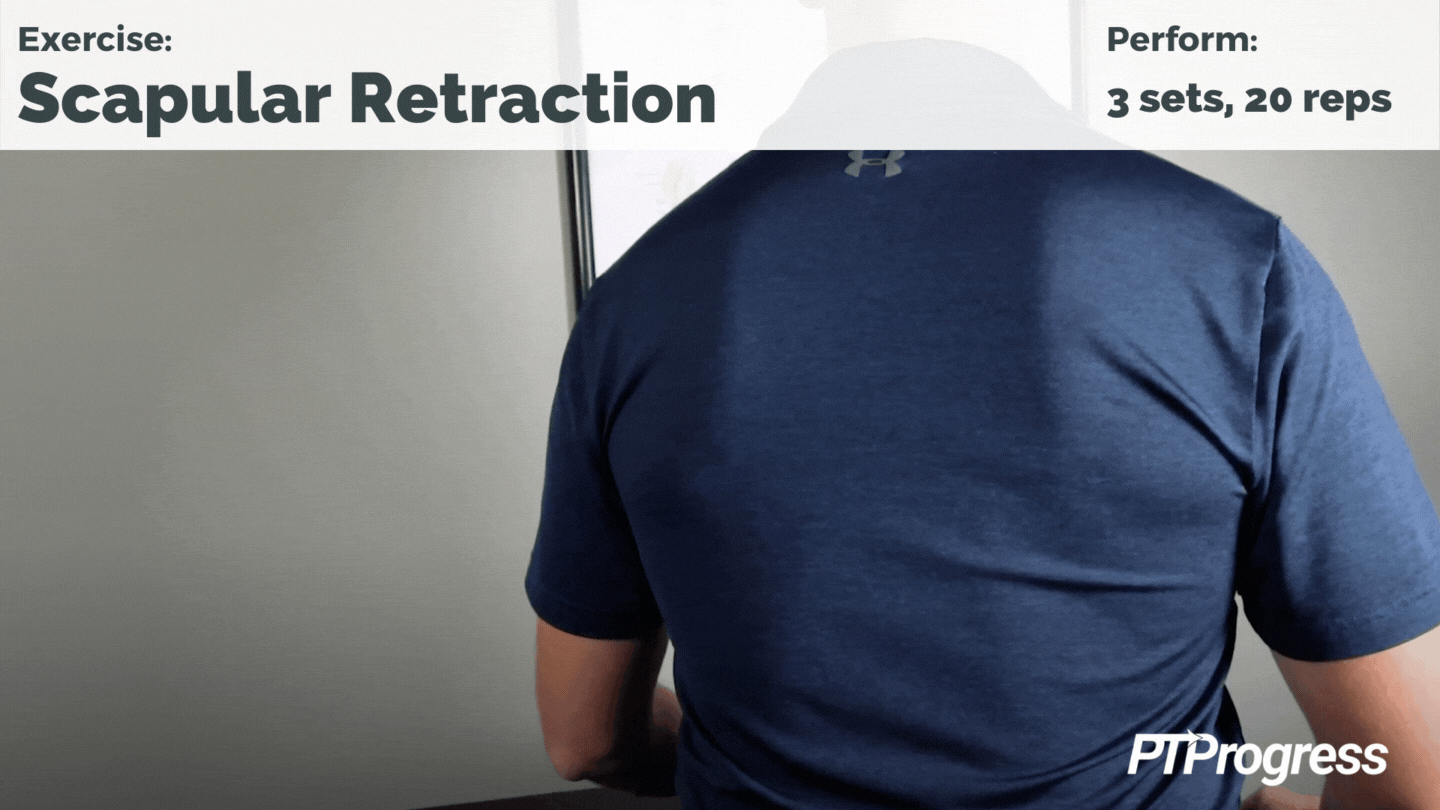
Keep your neck relaxed as you squeeze your shoulder blades together, holding for a few seconds at a time. Repeat 15 to 20 times.
This simple exercise is perfect to do every couple of hours, especially if you work behind a computer or find yourself sitting for long periods of time, contemplating your headache.
Pressure Points for Headaches: The Long and the Short
At the end of the day, chronic headaches are the result of several compounding factors, and pinpointing the exact cause can be tricky.
If you spend a lot of time in front of a computer or in forward head posture, there’s a good chance that your trigger points are referring pain to your head and neck, causing or worsening your headache.
Massaging these pressure points is a good idea and will bring immediate relief, but ultimately, straightening and strengthening your posture will more effectively prevent tension headaches.

